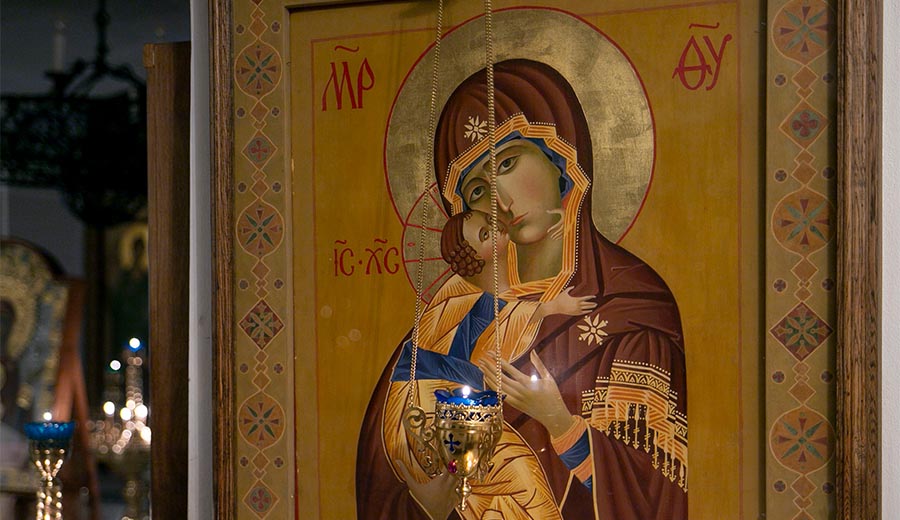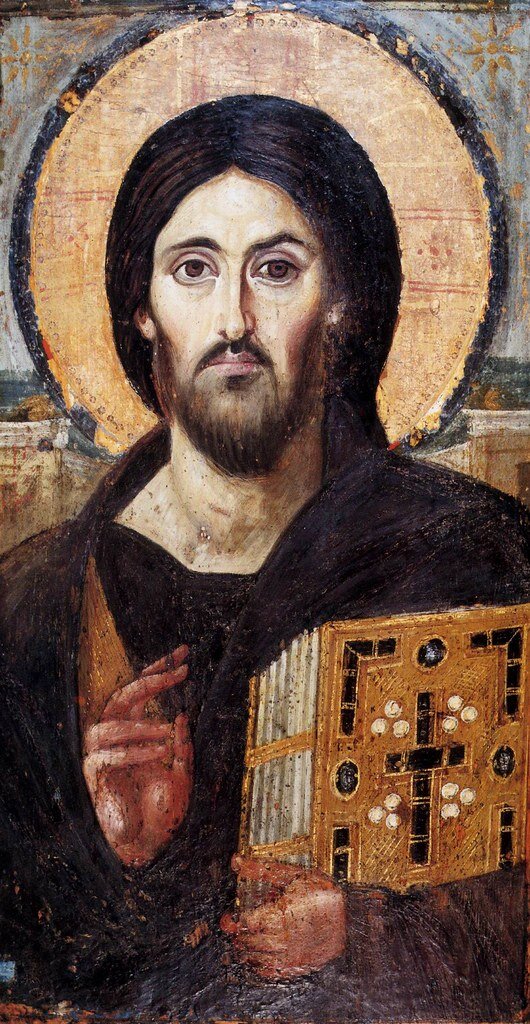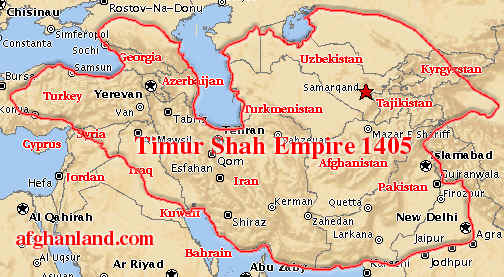
John 21:15-25 (Matins)
Philippians 2:5-11
Luke 10:38-42;11:27-28
The Heart of the Theotokos
".... blessed are those who hear the Word of God and keep it!"
In the Name of the Father and of the Son and of the Holy Ghost. Amen.
Our Lady of the Angels Hermitage was founded in Western Catholicism
and
dedicated to the Most Holy Mother of God.
The celebrations of Her feast days,
our recitation of the Angelus,
the Rosaries offered to Her individually and together,
our ardent prayers to her personally are all beyond numbering.
They are part of who we are,
woven into our DNA over the course of decades, so to speak.
Our humble presence beneath Her protecting mantle,
our hopes and joys and sorrows and fears confided to Her,
our petitions for Her intercession are part of a boundless Mystery
—
unsearchable, immeasurable, beyond quantifying by rational estimate.
As Roman Catholic faithful,
we never questioned whether Our Lady of Lourdes, Our Lady of Fatima, or Our Lady of Guadalupe
were different persons.
They are expressions of God's will that we receive guidance and inspiration
from our Holy Mother, Who was ordained by
Jesus:
"Behold, your Mother!" (Jn 19:27).
When we were received into Holy Orthodoxy
(a process that began about seven years ago),
I don't believe that any of us
were ready for the far greater depth and breadth of devotion
which is offered to the Holy Mother in the Russian Church.
We were overwhelmed.
She is boldly and frankly countenanced to be the Holy Mother of all,
and
all are expected to behave as her devout children,
who inescapably we are.
Of the Twelve Great Feasts of the Russian Orthodox Church,
seven celebrate Her or include Her as a principal.
The first Feast of the Church year is the Nativity of the Most Holy Theotokos,
and
the concluding Feast of the year celebrates Her Dormition.
She presided over the institution of the earthly Church at Pentecost.
She presides with Christ over the destiny of humankind,
a doctrine infallibly taught by
Fourth Ecumenical Council in 451.
This is a quite early council
which also taught that Christ had two natures.
That is to say she is organically interwoven into the very fabric of Christianity.
And She continues as the Queen of Heaven and Earth,
declared St. John of Damascus (An Exact Exposition of the Orthodox Faith, IV.14).
We at the Hermitage take special comfort that Hers was a monastic life
gracing the all-important Community of St. John
—
that prototype for all monasteries.
And still she
watches over us,
leading us,
directing us,
inspiring us,
protecting us,
and
censuring us when necessary.
She is glorious and exalted to the Heavens,
and
she is our loving, doting, scolding, guiding Mother,
Whose love cannot fail.
I will share briefly that I was puzzled by Our Lady of Fatima's statement
that Russia must be consecrated to Her Heart.
And then I remembered the date of that Divine declaration:
July 13, 1917,
the eve of the Bolshevik Revolution.
Her statement had nothing to do with Russia's conversion,
but an expression of Her extreme grief.
For Russia, which so loved her, and undoubtedly consecrated to Her Heart and for centuries
—
from the most humble peasant in the Taiga
to the Royal Family,
led by the Tsar who kneeled before Her icon and prayed.
Was there ever a country more consecrated to the Mother of God.
Yet, this inspiring example of a whole lifeworld
dedicated to Her
was about to suffer the most furious depredations that atheists
could deal out.
As I have said, more than 100,000 clergy were murdered
under the Soviet regime,
and
drunken, riotous soldiers defiled Her churches and icons
for decades
throughout Holy Rus'
—
an extent of twelve time zones.
Her expression of love to the Russian Orthodox faithful
is best known through her many icons.
This sacred tradition is traced back to the Evangelist St. Luke,
who rendered three types that we know of:
the Umilenie (Tenderness) icon,
the Hodigitria (the Guide),
and a third type offering Herself (without Child)
or
praying
to the Christ Child
(which is called the Oranta style).
Now, I do not say that St. Luke depicted them
as in executing a model.
For that would be to objectify them .... as if they could be geometrically determined.
Icons are not representational art.
They do not celebrate or exalt beauty.
(Nor do they protest against beauty).
They call us away from things of earth
and
enable us to contemplate the mystery of Heavenly Things.
This is but one reason they are not idols
—
they are not creaturely,
but spiritual.
Take, for example, the Icon of Vladimir Mother of God.
It does not depict Christ and the Theotokos.
It is something else .... lets us say a swirl of intimacy and holy affection.
Icon are, as it were,
a window unto Heaven,
an elevation of the soul,
and
a participation in the Kingdom of God.

In this,
they are not analogous to paintings or to any kind of art.
Icons of the Son of God participate in the very properties
of the Incarnation.
To say that they are outward, material signs
of an inner grace is not saying enough.
They are Heaven's incommensurable Power made manifest
—
the Power which created the universe,
the Power which effected the salvation of humankind,
the Power which alone Is in sense of Pure Being,
the Subject of subjects ....
like the Incarnate God, Who was rendered materially.
We at the Hermitage have not dared to display
more than one icon of Christ
—
that awesome icon ....
and
that the oldest icon of our Creator, Savior, and Judge:
the Pantocrator of Sinai.
The Most Holy Mother of God also possesses an Incarnational grace.
She is the first human to attain the goal of the Incarnation,
which is the deification of man,
which we celebrated in the Feast of the Dormition,
which is the festal culmination of the Church Year,
what it has been all about.
Commensurate with Her Divine Power,
Her icons
are instruments of Her grace ...
to be approached and venerated
as we would Her Most Holy Person.
Many of them,
even paper copies,
stream myrrh,
the holy resin associated with devotion to Her Son.
They are fragrant of roses.
What is the underlying source of this marvel?
Whence does myrrh proceed?
This is like asking where do angels come from?
Have you ever encounter angels?
They are simple there,
and
then they depart.
When I first encountered a myrrh-streaming icon,
I suppose I thought it a miraculous singularity.
Why would it be hidden from the general view?
Why was there no fanfare?
But such things are holy and not to be gawked at.
They are part of the atmosphere
of
the Kingdom of God,
which is coterminous with the Orthodox Church.
They are to be expected,
for all things
properly and sincerely administered within the Church
are Divine.
That is what the Church is:
"on earth as it is in Heaven."
When we enter the catechumenate, this marks our decision
no longer to be part of the world.
At the point of our illumination (baptism),
rejection of the world is explicit in our vows.
(Do you recall?)
Indeed,
we actually spit upon the evil one,
who is the ruler of this world (Eph 2:2, 2Cor 4:4).
We are welcomed into the Kingdom by her many incorrupt saints,
who preside over
this empyreal realm.
An Orthodox patriarch,
His Beatitude Jonah,
told me that when he was a young monk
(following the collapse of the Soviet Union),
he ventured with others to the great monastery at Valaam
to rehabilitate and restore its neglected buildings.
He explored the old monastery as through a great ruin.
Passing a door,
he noticed the faint scent of roses.
And
when he opened the door
he entered into a cloud of fragrance.
Stacked on shelves, he discovered many icons, crosses, and other
sacred furnishings
dripping with myrrh.
They were all dripping with myrrh.
When he visited the Hermitage for a week-long retreat,
Metropolitan Jonah brought with him
a holy relic of His Holiness Patriarch Tikhon
and
an icon of the Theotokos of Valaam.
We cherish them both.
For both are holy treasures.
The Russian Church Calendar liturgically venerates 260 wonderworking icons
of the Most Holy Mother of God.
The Menaion specifies 700.
Because I have seen icons not mentioned in the Menaion,
it is probably better to say that this number
just begins to point to an abundance of grace
beyond numbering.
As Her Person is as many-faceted as our needs and prayers,
so these icons have many dimensions.
In one familiar example,
She spoke through Her icon
to a broken, confused
girl lost in promiscuity,
which would be the turning point in the life of one of our greatest saints.
Our Mother would speak to each of us and all of us
if we would but entreat her.
☦

During the late fourteenth century,
the conqueror called Tamerlane the Great was amassing
the largest Muslim empire of its time
—
one massacre after another
aiming always for genocide.
At his height,
he was the bloody master of a territory including or touching upon
the modern-day states of India,
Pakistan, Kuwait, Iraq, Iran, Syria, Turkey, Azerbaijan, Armenia, and Georgia.
Allied with the Golden Horde,
his armies approached Moscow in 1395.
Vasily I, Grand Prince of Moscow, led an army to Kolomna,
sixty-five miles away,
pausing at the Oka River.
The clergy brought the
renown wonderworking icon the Theotokos of Vladimir to the head of the assembled host.
During the icon's solemn procession from Vladimir,
the faithful knelt
and prayed,
"O Mother of God, save the land of Russia!"
And upon the arrival of the icon, Tamerlane's armies inexplicably retreated.
Forever after,
thanksgivings are offered by the Church
on August 26
(today)
for this miraculous deliverance of the Russian land.
Such events are not deterministic.
They are not repeatable upon human demand.
They are instances of Divine Grace, not to be predicted.
As St. Paul has written of the Divine Will:
|
"I will have compassion on whom I will have compassion."
(Rom 9:15)
|
Following the seventeenth- and especially the eighteenth century, however,
the West has demanded that the deterministic underpinnings of all things in the contingent world
be demonstrated.
This revolution in intellectual history
is a complex subject
and
certainly beyond the limits of a Sunday reflection
(the Sisters hear in relief!).
The short version is that about a thousand years ago,
the discovery of the Organon of Aristotle
would fundamentally change everything forever in the West.
We vainly attempt to think of another event comparable to it.
It flipped the way we do everything, think of everything.
A new technology
(Aristotle's students called it an instrument)
had appeared, and it was employed everywhere.
Scholars in the West avidly applied it to theology,
birthing
a new philosophical system: Scholasticism.
And
all theology in the West would be dominated by it for the next thousand years.
reaching a "booster" stage with the birth of the Western saint
Thomas Aquinas and the composition of his Summa.
Accordingly,
during the eleventh-century
(when the Aristotelian revolution began),
two opposing cultures would be established:
the ancient order in the East
—
the One Holy Catholic and Apostolic Church
—
and
the new order in the West
—
the Roman Catholic Church.
Their mutual antagonisms would be formalized in the Great Schism of 1053.
The new Church would have almost nothing in common with
its ancient parent
thanks to the Organon,
which continued its iron grip on the Roman Church for the next thousand years,
confirmed through the writings
of Anselm,
Peter Abelard,
Albertus Magnus,
Duns Scotus,
William of Ockham,
Bonaventure ....
all of whom accounted themselves to be disciples of Aristotle.
Most of the Doctors of the Roman Catholic Church
should really be called the "School of Aristotle."
Thus, was the Roman Church conceived in a culture that gave pride of place to intellectual reason.
I remember walking past a classroom in a parochial school many years ago.
A banner was posted high on the wall similar to the Alphabet poster hung in public schools.
It read,
"Mathematics is the Language of the Mind of God."
It disclosed a certain point of view ....
a thousand years after the Organon was discovered.
Meantime,
the Kingdom of Heaven still abides on the earth.
The original Catholic and Apostolic Church continues serene and undisrupted.
Where Holy Orthodoxy is duly established and venerated with sincere hearts
—
where the Holy Days are kept,
where the prayers are ardently prayed,
where the seasonal fasts are observed,
there
the air is thick with the presence of angels and saints and
the manifest grace of God.
Without question,
here is a place of mystery,
here is a place that defies rationalism but graciously
opens the way to paths that go beyond and above our intellectual grasp.
In an era when the Roman Church had become thoroughly inured to rationalism,
the mathematician Blaise Pascal wrote,
"The heart has its reasons, which reason knows nothing of"
(Pensées, 1670).
In the Name of the Father and of the Son and of the Holy Ghost.

